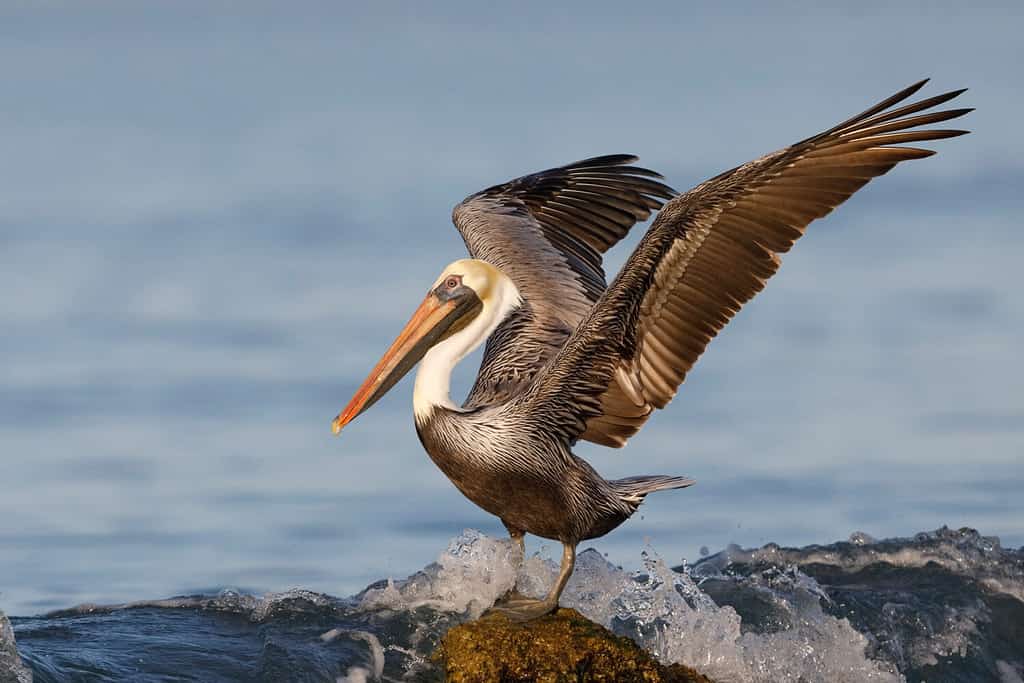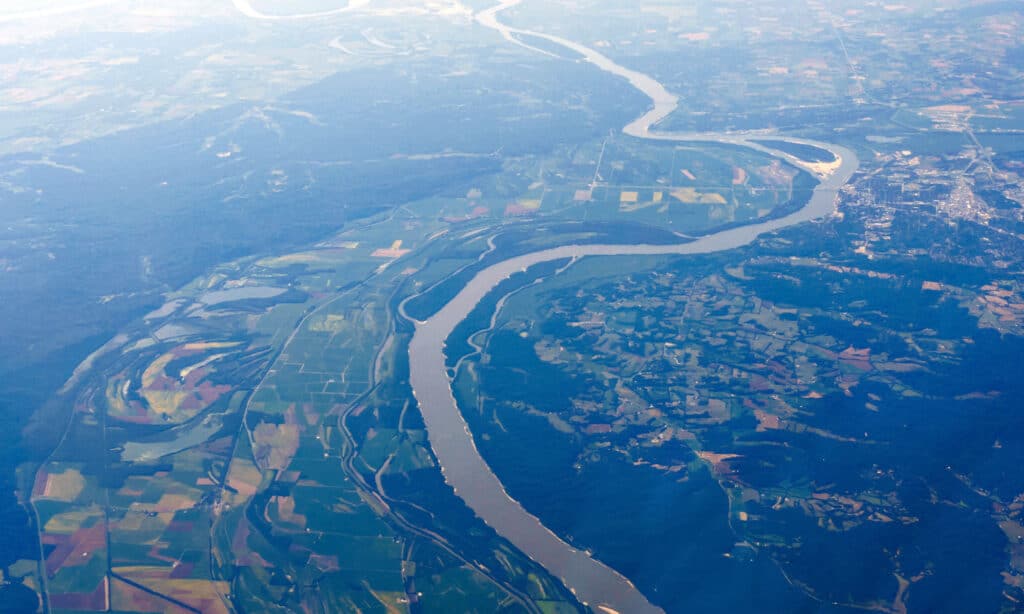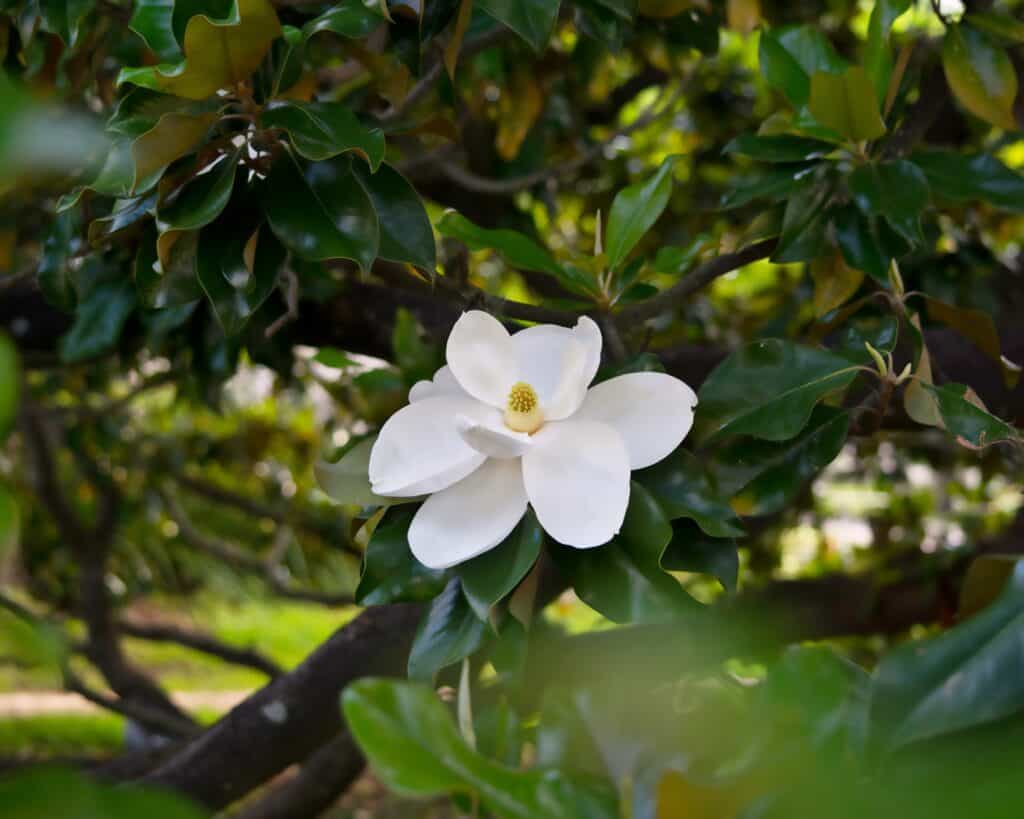Louisiana is a fascinating state with plenty of mystery, history, and great Cajun food. With plenty of places to explore a unique natural environment as well as walk some of the most interesting paths of history, there is something to see for everyone visiting this state. Here are some of the most fun facts that we think make this state something truly special.
#1 Louisiana is known as The Pelican State.
The brown pelican is the official state bird, which also makes an appearance on the state flag. Why the brown pelican? Early settlers to Louisiana marveled at the sheer number of pelicans that they saw on the Louisiana’s coast. Pelicans are also famous for caring for and nurturing their young. The image of a pelican watching over a nest of babies is prominent on the Louisiana state flag.

You can see pelicans on the state’s coastline and featured on the state flag.
©Brian Lasenby/Shutterstock.com
#2 Lousiana’s Lake Pontchartrain Causeway is the longest bridge over water in the world.
This 24-mile bridge is the longest continuous bridge over water in the world. It connects New Orleans with other communities on the other side of Lake Pontchartrain. The bridge requires 9,500 supports and was opened for traffic in 1956.
#3 Mardi Gras draws in over 1.4 million visitors each year.
Mardi Gras is celebrated around the world but no city does it quite like New Orleans. Around 1.4 million people come to Louisiana each year to participate in the festivities. The celebrations ramp up and are the largest in the two weeks leading up to Ash Wednesday each year. Parades, live music, delicious food, and round-the-clock parties bring in a joyful atmosphere.

The iconic Mardi Gras colors include purple, green, and gold.
©Jean Faucett/Shutterstock.com
#4 Baton Rouge’s capital building is the largest in the U.S.
The Louisiana State Capital building in Baton Rouge is 450 feet tall and has 34 floors. The Old State Capital, also in Baton Rouge, is now a museum and also worth a visit.
#5 Lousiana has a large alligator population.
A visit to Louisiana should definitely include an alligator sighting or two since there are as many as 2 million of these animals in the state. They frequent the swamps and bayous of Louisiana. You can take a boat ride to see them or even enjoy a taste of alligator jerky.

The American alligator was once an endangered species, thanks to hunting and habitat loss. However, legal protections have allowed these reptiles to rebound and thrive.
©Leafyplant at the English Wikipedia, CC BY-SA 3.0 – Original / License
#6 Louisiana was predominantly settled by the French.
Many of the settlements in early Louisiana were French. This resulted in a strong influence from the French language, food, and customs. Many of the names of streets, cities, and parishes in the state have French origins. Louisiana began as a French colony. Later, it became part of Spain and finally part of Napoleon’s France. Napoleon sold the extensive area to the United States in 1803 as part of the Louisiana Purchase.
#7 One of the most devastating storms in modern U.S. history struck Louisiana.
2005’s Hurricane Katrina caused over $100 billion in damages, mostly concentrated near New Orleans and surrounding areas. Over 1,800 people died as a direct result of the hurricane and flooding. It was the most expensive natural disaster on record.

Over 80% of New Orleans was flooded by Hurricane Katrina, destroying 100,000 homes and businesses.
©Tad Denson/Shutterstock.com
#8 Lousiana has parishes instead of counties.
This is the only state to divide in this way. Instead of counties, Louisiana has parishes that function in a very similar way. This is due to the heavy influences of Catholic settlers, many of whom were French, in the early days of Louisiana’s modern history.
#9 Poker was invented in New Orleans.
Known for its tendency to embrace big living, many people consider New Orleans the birthplace of modern poker. It began around 1829 when played by French settlers. Like poker today, the early game involved bluffing to gain the upper hand against your opponent. Players placed bets to see who could win the game.
#10 Cajun culture is important in Louisiana.
Cajuns hold strong ties to early French-speaking settlers in Louisiana, mostly in the southwestern parts of the state. The term Cajun has expanded to refer to culture, food, and traditions unique to this area and history. Creole, on the other hand, refers to the specific ethnic group of people descended from these settlers.

Food, such as gumbo, is an important and delicious part of Louisiana’s culture and heritage.
©Kravtzov/Shutterstock.com
#11 The Louisiana Purchase included 13 modern-day states.
The 1803 purchase of land from Napoleon included much more than just present-day Louisiana. Modern-day states include Arkansas, Iowa, Kansas, Missouri, Nebraska, Oklahoma, parts of Colorado, Minnesota, Montana, New Mexico, South Dakota, Texas, Wyoming, and, of course, Louisiana.
#12 There are four predominant languages spoken in Louisiana.
Louisiana does not have an official language. Instead, English, French, Spanish, and Vietnamese are all spoken in different regions. Louisiana Creole and Cajun French are subdialects that are unique to this region. French and English heavily influence vocabulary and pronunciation, with additional words from African and Native American languages. Some experts consider Louisiana Creole a distinct language.
#13 The only battle in the American Revolution outside of the 13 colonies took place in Louisiana.
The British and Spanish forces fought the Battle of Baton Rouge over control of the Mississippi River in 1779. The siege of the British-controlled fort resulted in the seizure by the Spanish, who were on the side of the American forces.

At its deepest point, the Mississippi River can reach 200 ft!
©RaksyBH/Shutterstock.com
#14 Driskill Mountain is the highest point in Louisiana.
At 535 feet of elevation, Driskill Mountain is in Bienville Parish in northwestern Louisiana. Once you get to the top, you’ll see a small pile of rocks marking the summit.
#15 New Orleans is the lowest point in Louisiana.
On the other end of the spectrum is New Orleans, which sits below sea level. Repeat storms and hurricanes have further eroded parts of the city. Some places are as much as 8 feet below sea level.
#16 The first opera in the U.S. was performed in Louisiana.
The first opera performed in the United States, Sylvain, took place at New Orleans’ Theatre de la Rue Saint Pierre in 1796.
#17 The largest swamp in the U.S. is in Louisiana.
The Atchafalaya Basin is the largest river swamp in the United States. The swamp covers almost 1 million acres and goes on continuously for 140 miles before it empties into the Gulf of Mexico. The swamp is home to numerous species of birds, fish, and animals. Some of the most notable include alligators, crawfish, black bears, and bald eagles.

Larger than the Florida Everglades, the Atchafalaya Basin is home to a huge number of species of flora and fauna.
©U.S. Army Corps of Engineers, photographer not specified or unknown, Public domain, via Wikimedia Commons – Original / License
#18 The first American female self-made millionaire was from Louisiana.
Madam C.J. Walker, an entrepreneur who developed and sold cosmetics, was originally from Delta, Louisiana. Although other members of her family were enslaved, she was born free just after emancipation. She created and marketed cosmetics for black women and was a prominent figure in politics, business, and philanthropy throughout her life.
#19 The French Quarter is the oldest neighborhood in New Orleans.
New Orleans’ French Quarter is one of the most iconic neighborhoods in this historic city. Unique architecture, music, food, and hospitality make the French Quarter one of the most-visited parts of New Orleans. It dates back to the early 1700s when it was home to French settlers in the city.
#20 The magnolia is the state flower.
Magnolias abound throughout the state and make a bold visual statement with their large, cream blossoms and dual-colored foliage. It has been the state flower of Louisiana since 1900.

Southern magnolia flowers have a sweet, lemony fragrance often used in aromatherapy to induce a calm feeling and atmosphere.
©iStock.com/Dwbenjam
#21 Louisiana was named after a French King.
The state was named after King Louis XIV by French settlers in 1682. Even though the Spanish were also important European settlers in the area, the French claimed the land and named the city.
#22 Jazz legend Louis Armstrong is from Louisiana.
Born in New Orleans, the music and culture of his hometown city strongly influenced Louis Armstrong. He was a skilled trumpet player and jazz musician who helped put New Orleans on the map as the birthplace of American jazz.
#23 Bourbon Street is named after a French royal family.
During New Orleans’ construction, the engineer behind the city’s design named the street Rue Bourbon after the royal family in France at the time of its construction. Today, Bourbon Street is one of the most active areas in New Orleans nightlife, especially during the Mardi Gras celebrations.
#24 Louisiana has over 50 National Historic Landmarks.
Many buildings and architectural sites around the state make the list. New Orleans’ St. Charles Streetcar Line is one of only two mobile national historic sites in the country.

Take a ride on the historic St. Charles Streetcar in New Orleans.
©f11photo/Shutterstock.com
#25 The many mausoleums in New Orleans and other cities are due to the city’s low elevation.
Because the city sits at or below sea level, many cemeteries in New Orleans feature above-ground mausoleums rather than the below-ground gravesites common in other parts of the country. Funeral services in Louisiana, especially in New Orleans, often include jazz bands. These bands play funeral marches on the way to the cemetery and joyful, celebratory music following the service.
#26 Louisiana was the last stand of Bonnie and Clyde.
The infamous couple known for robbing banks and being crazy about each other Bonnie and Clyde were killed in Louisiana. After a long pursuit, authorities ambushed and killed Clyde Barrow and Bonnie Parker in Bienville Parish, Louisiana.
#27 Tabasco was invented in Louisiana.
The recipe of the Tabasco sauce company was made of peppers grown on Louisiana’s Avery Island and patented by the McIlhenny Company.
#28 The first American cocktail was invented in Louisiana.
The Sazerac, a cognac-based cocktail, was invented around 1850 in a New Orleans bar. Its inventor named it for the brand of cognac used in the cocktail. Today, some bears use whisky but it should always include Peychaud’s Bitters, also invented in New Orleans.
#29 The oldest North American earth mounds were made in Louisiana.
Poverty Point is a UNESCO World Heritage site in Louisiana and home to earthen mounds built around 3,400 years ago.

Poverty Point is a major historic site in Louisiana.
©Zack Frank/Shutterstock.com
#30 Oil is a major export in Louisiana.
Oil refineries make up a significant portion of the state’s economy, accounting for as much as 25% of the state’s revenue.
The photo featured at the top of this post is © iStock.com/Sean Pavone
Thank you for reading! Have some feedback for us? Contact the AZ Animals editorial team.







